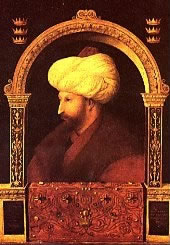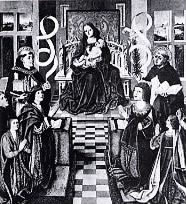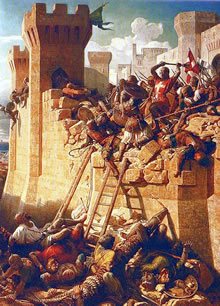The Crusades
... those who live like this will not inherit the Kingdom of God.
~ Galatians 5:19-21
The Crusades were Christian wars against non-Christians, and even against Christians of a somewhat different persuasion, staged between 1095 and 1248. No Christian can ignore the shame that the Crusades have brought on the Christian church, especially in the eyes of Jews and Moslems. Modern evangelical churches sometimes use the word Crusade to describe an outreach program in their local area, overlooking the fact that Jews and Moslems associate the concept of a crusade as an attack of terror on their communities.
A brief history of the Crusades
... the conditions that led to their launch, and the consequences.
- ca 1050 AD onwards
Resurgence of wealth in Europe after the Dark Ages led to new confidence in the Christian Empire.
- 1095
The Emperor in Constantinople, capital of the eastern half of the Christian Empire, called for help in his campaigns against growing Moslem strength.
Pope Urban II in Rome called on Christians in Europe to join a crusade to liberate Jerusalem from the Moslems.
- 1096
Crusaders marched in several armies towards the Holy Land. In cities across Europe they slaughtered defenceless Jews.
The first armies arrived at Constantinople and crossed the Bosphorus to attack the Turks. One of those armies, that of Peter the Hermit, was massacred.
Multitudes died, many of starvation, in the two-year march to Jerusalem.
- 1099
Crusaders from Europe conquered Jerusalem, slaughtering Moslems, Jews and eastern Orthodox Christians alike.
- 1101-1144
Crusader states were established in the Holy Land.
- 1140-1300
Period of building the great Gothic cathedrals in Europe – dedicated mostly to the virgin Mary, and some to saints, being places where relics of these people were stored. Pilgrimages to such shrines were thought to bring power for answers to prayer.
The cathedrals were the most visible display of the “church triumphant.”
- 1146-1148
Second Crusade – a failure.
- 1187
Moslems led by Saladin reconquered Jerusalem.
- 1189-1192
Third Crusade – a failure.
- 1200-1204
Fourth Crusade – Latin Christians from Europe, and an army financed by Venetian merchants, conquered the eastern Orthodox centre of Constantinople, killing “fellow Christians” and taking the treasures of Byzantium to palaces in Europe.
Although the armies of Rome withdrew some decades later, allowing the Orthodox Christians to re-settle Constantinople, the eastern half of the Christian Empire was so weakened that it easily fell to the Ottoman Turks in 1453.
Mehmet II, the Moslem conqueror of Constantinople.

The city was renamed Istanbul.
To this day the country of Turkey represents the major boundary between Europe and the Moslem domination of the Middle East.
- 1209-1229
Albigensian Crusade in Europe.
Heresy took hold in southern France and, through military conquest, Rome forced its exclusive right to interpret and deliver doctrine.
- 1219-1221
Fifth Crusade to “save” the Holy Land – a failure.
- 1229
Sixth Crusade – a failure.
- 1231
Start of the Inquisition – the church’s attempt to enforce doctrinal orthodoxy throughout Christendom.
- 1248
Seventh Crusade – a failure.
- 1252
Pope Innocent IV sanctioned the use of torture to extract truth from suspects brought before the Inquisitors.
Painting by an unknown artist of “The Virgin of the Catholic Monarchs.”

Kneeling behind King Ferdinand is Torquemada, the first Inquisitor General of Spain.
- 1347-1350
Black death – bubonic plague killed one-third of the population of Europe.
- March 2000
Pope John Paul II admitted the sins of the Catholic Church going back to the Crusades and the Inquisition and, in a sermon that was broadcast live to the world, asked for forgiveness.
Related messages:


